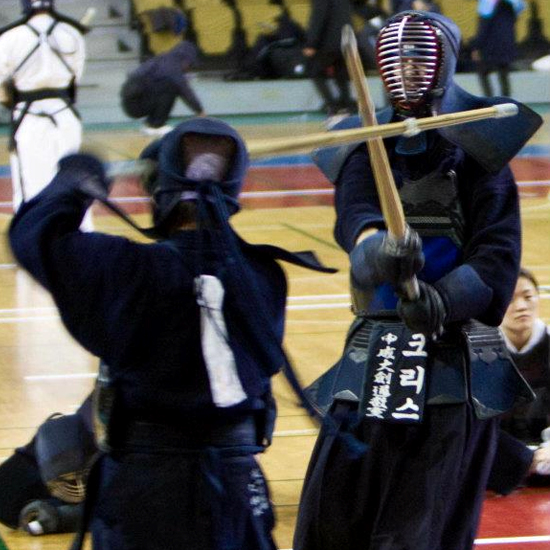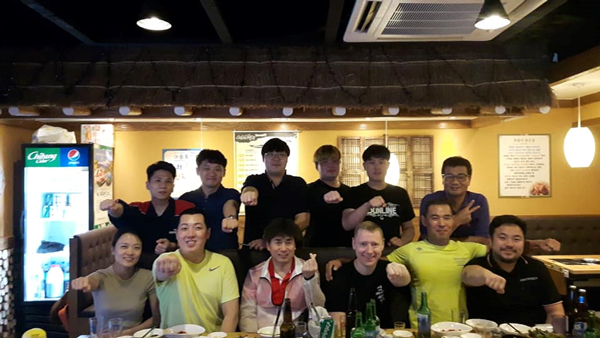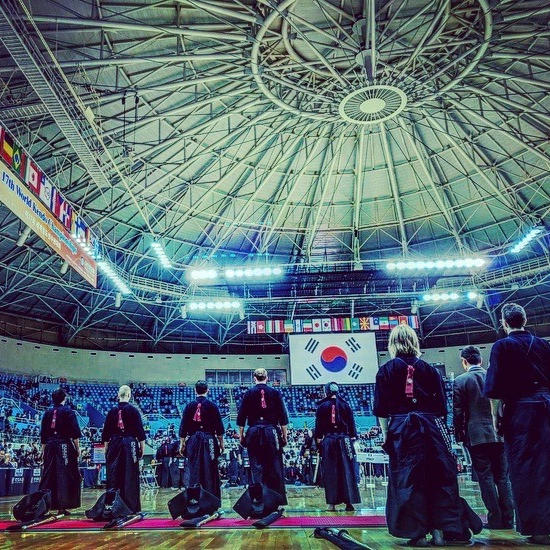Practicing overseas can be a great opportunity to experience other methods of teaching and of improving ourselves. This week we spoke with Chris Bowden, Ichi Byoshi Dojo Instructor and GB Kendo team member, about his experiences learning outside the UK, specifically in Korea where lived and had the opportunity to start learning Kendo.
1.When did you start practicing Kendo in Korea and how long did you stay there?
I was first nagged by a friend to try kendo. To be honest I wasn’t really interested, but once I tried it there was no turning back. I quickly developed a keen interest and wanted to make up for starting late. I trained up to twice daily, participated in competition and took gradings. I returned to the UK in 2012 having developed a deep passion for kendo. I set myself two goals on the returning flight back from Korea. The first was to be selected for the national team, which I am happy to say I have achieved. The second was to increase the availability of Kendo in the UK, so my dream is to have a Dojo that can be used on a full-time basis.
2. How many days a week did you usually practice and how was the routine there?
I practised Monday to Friday for 1 hour in the evenings. I often tried to get to the class before so that I could practise with the high school students. It is hard to imagine only doing an hour of kendo nowadays, but there was a very strong attitude of making the best use of time in class. I have found this one of the biggest differences when practising in the West. Part of being a diligent student is to be ready to be taught, this meant things like removing armour quickly ready to hear any feedback or instruction, lining up quickly and listening to what was being asked. You were not only there to improve yourself, but you were trying to not impede others’ learning also.
3. Did you do any exams in Korea? How was it?
I took 1st to 3rd dan in Korea, which was very daunting. I had to do my 1st and 2nd Dan written examinations in Korean, but thankfully for my 3rd Dan I was allowed to do it in English. Grading wise it was slightly different in structure. Candidates are split into two groups, one half do written tests and Kata, and the other group do their practical tests. Compared with gradings that I have attended in Europe and Japan where I always felt bad that some examinees don’t get to demonstrate the Kata they worked so hard on. Fortunately, I haven’t experienced this and I am keen to avoid it. I put a lot of thought, a long time ahead of grading, as I prefer not to fail, even if it is another opportunity to learn.
4. And what about tournaments?
Once I had trained for a while I wanted to experience Shiai, so I began to enter tournaments, usually 3-4 a year. The tournaments were split into Kyu grade to 3rd Dan and then 4th Dan upwards were held separately. The tournaments were very large and had a great atmosphere. The tournaments I experienced were open, but segregated by age. I learned a great deal from the experiences and they always drove me to improve the quality of my kendo. I even won some medals as an individual and with my Dojo team and also got to be part of the Pusan north district team, which was a big competition for me. My age and grade always seemed to be on early or even before the opening ceremony, which meant a long day if I were knocked out, especially as the kids at my dojo usually got medals.

5. What differences can you point out about training in Korea and here in the UK?
In Korea it is very common for people to have a hobby or past time. They tend to be more geared towards self-improvement, so budo, sports, music and arts and culture are very popular. As a result, there are many places to learn these things and they are relatively inexpensive. I was encouraged to train every weeknight and there were lots of meals out and even day trips as a dojo. There was a strong community bond, and many members would join us at social occasions long after stopping Kendo. Most of them talked about taking it up again, which seems common in Western Dojo too. The attitude towards training was once of diligence. You were expected to work hard and make the best use of your time. Our Dojo motto was ‘Correct body, Correct attitude, Correct sword.” When I had the opportunity to return to Korea as part of team GB for the WKC I was able to revisit my Dojo and see all my old classmates again. It was an emotional moment to see the bond was still there.
6. As the Ichi Byoshi Instructor, what is the most important thing that you learnt in Korea that you try to pass on to your students?
The most important aspect that I learned about Kendo from Korea was that it was my journey of improvement. My instructors and classmates could help me, but ultimately, I was responsible for doing the work. I hope that the students of Ichi Byoshi understand this, but also put it into practice. The situation in the UK is different and people struggle to balance their lives, however the challenge remains the same. My ultimate dream is to create a full-time dojo so there is always an opportunity to train. One of the biggest lessons my Sensei taught me was - once when I had broken my right hand, I sent a message to my Sensei to inform him that I was unable to attend practice due to my broken hand. He replied with one word “footwork”. So I went to training and spent several weeks doing all my training one armed. This taught me a lot about how to swing a shinai with the left arm, but more importantly that adversity provides opportunity. This is the thought that has been forefront in my mind during this pandemic. My thoughts are that during the pandemic many people should be working on footwork, Suburi and Ki-ken-tai-no-ichi. The break will have been a wasted opportunity if you turn up to the Dojo and you haven’t improved in these areas. The opportunity is there to build strong foundations that you will be grateful for in years to come.
7. People usually say Kendo and Kumdo are two different things. What are your thoughts about that?
There is a lot of misconception about this topic I feel. Firstly ‘Kumdo’ is the Korean pronunciation of the Kendo Kanji. After that, the issue can be split into two main categories.
Korean Kendo
In Korea there is the Korean Kendo Association, which is equivalent to the British Kendo Association, but there is also another smaller association that practises ‘Korean Kendo’. I don’t really know much more than that as when I asked my Sensei about it, I was told not to worry about it. But it is this ‘Korean Kendo’ that gets talked about as being different.
Differences from international Kendo
Fundamentally Korean Kendo teaching follows the same principals as Japanese Kendo or British Kendo. However, they have a slightly Korean flavour that comes out, much in the same way each country has their own style. The Korean national sport is Taekwondo and every person who completes their national service trains to at least 1st dan. So, I think that it is no surprise that this influences how Koreans develop their Kendo. Younger Korean’s tend to be fast, aggressive and use a lot of Renzoku Waza, which is very distinctive to see, but older Koreans, like everyone, else cannot practice kendo in this way, so you would be less likely to notice them.
There are however some very distinct cultural differences in the practices in the Dojo. These differences are mostly the removal of some Japanese cultural customs as Korea was only liberated from Japanese colonisation after WW2 and so observing Japanese customs that were imposed previously was a sore point. The most significant differences are firstly, the classes are entirely in Korean. The vocabulary is pretty much the same, just in Korean. This meant I had to start learning the Japanese terminology very quickly when I returned to the UK. Occasionally I still say things in class in Korean and only realise from the baffled looks of the students.
Next there is the Korean national uniform. I don’t know why it exists, I just see it as being something akin to the New Zealand rugby team’s haka, a unique quirk to the art. It is for the Korean national team; however many young Koreans like to wear it like kids wearing national team football shirts.
Another distinctive difference is the use of blue and white flags instead of red and white. These colours were changed to reflect the Korean flag rather than the Japanese. The last one that springs to mind is the absence of Sonkyo. Jigeiko and matches simply start from a standing position. This was another thing I had to get used to when I returned to the UK. I have to say that coming to Sonkyo later in my kendo life was a bit weird, but it is a great test of balance and core strength.
8. What do you miss the most?
I miss so much about life in Korea, the food and the culture are great, but a lot of it I can replicate or I can contact friends. The one thing I cannot replicate is having a dojo a 5-minute walk from my apartment open 5 days a week that lived and breathed Kendo. It is something I wish I could provide to the Kendoka in the UK. I must mention that I miss my Sensei and my instructor who both taught me so much about Kendo and were passionate about helping me. Without their help and patience, I would never have had a dream, let alone have achieved it.


